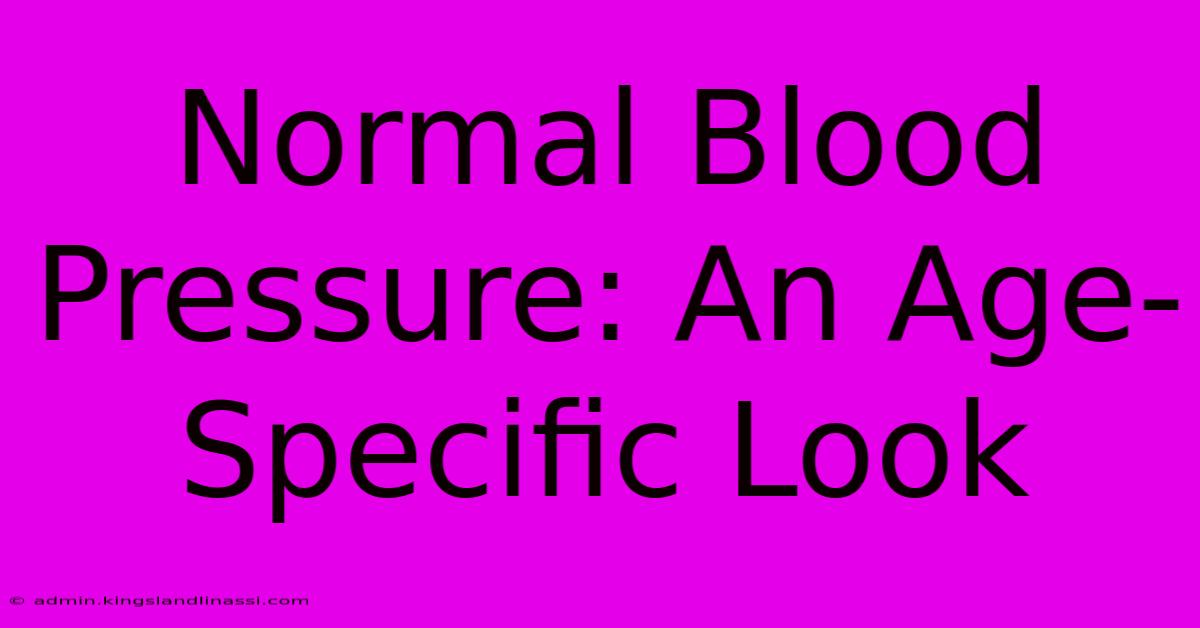Normal Blood Pressure: An Age-Specific Look

Table of Contents
Normal Blood Pressure: An Age-Specific Look
Maintaining a healthy blood pressure is crucial for overall well-being, but what constitutes "normal" can vary significantly depending on your age. Understanding these age-specific ranges is key to proactive health management and preventing potential heart problems. This comprehensive guide will break down normal blood pressure by age group, providing insights into healthy habits and when to seek professional medical advice.
Understanding Blood Pressure Readings
Before we dive into age-specific ranges, let's quickly review what a blood pressure reading signifies. Blood pressure is measured in two numbers:
- Systolic Pressure (the top number): This reflects the pressure in your arteries when your heart beats.
- Diastolic Pressure (the bottom number): This reflects the pressure in your arteries when your heart rests between beats.
These numbers are expressed in millimeters of mercury (mmHg). For example, a reading of 120/80 mmHg means a systolic pressure of 120 and a diastolic pressure of 80.
Normal Blood Pressure Ranges by Age Group
While there's no single "perfect" blood pressure, guidelines generally categorize blood pressure as follows:
Children and Adolescents (up to 18 years):
Normal blood pressure for children and adolescents varies considerably depending on age, height, and weight. It's crucial to consult your pediatrician or family doctor for age-appropriate blood pressure ranges and regular checkups. They can track your child's blood pressure over time and address any concerns early on. Regular exercise, a balanced diet, and limiting screen time are essential for healthy blood pressure development in this age group.
Adults (18-60 years):
For adults aged 18 to 60, a blood pressure reading of less than 120/80 mmHg is generally considered ideal. Readings between 120/80 mmHg and 139/89 mmHg fall into the prehypertension range, indicating an increased risk of developing high blood pressure. Consistent monitoring and lifestyle modifications are recommended at this stage.
Lifestyle changes to maintain healthy blood pressure in adulthood include:
- Regular Exercise: Aim for at least 150 minutes of moderate-intensity aerobic activity per week.
- Balanced Diet: Focus on fruits, vegetables, whole grains, and lean protein, while limiting sodium, saturated fats, and processed foods.
- Weight Management: Maintaining a healthy weight reduces strain on the heart and circulatory system.
- Stress Reduction: Practice relaxation techniques like yoga, meditation, or deep breathing exercises.
- Limit Alcohol Consumption: Excessive alcohol intake can significantly raise blood pressure.
- Quit Smoking: Smoking damages blood vessels and contributes to hypertension.
Older Adults (60 years and older):
Blood pressure guidelines change slightly for older adults. While the ideal remains below 120/80 mmHg, some health professionals consider a systolic pressure below 150 mmHg and a diastolic pressure below 90 mmHg as acceptable for this age group. This is because some age-related changes in blood vessels can lead to slightly elevated readings. However, it's crucial to consult with a doctor to determine the appropriate target blood pressure based on individual health conditions and other risk factors.
Specific considerations for older adults include:
- Regular Blood Pressure Monitoring: More frequent monitoring is advisable to detect any significant changes.
- Medication Management: Many older adults may require medication to manage blood pressure. Working closely with a physician is vital.
- Fall Prevention: Low blood pressure can increase the risk of falls; maintaining hydration and addressing any medication side effects is crucial.
When to See a Doctor
Regardless of your age, you should consult your doctor if:
- You consistently have blood pressure readings above the recommended ranges.
- You experience symptoms like dizziness, headaches, shortness of breath, or chest pain.
- You have a family history of high blood pressure or heart disease.
Early detection and management of high blood pressure are crucial to preventing serious health complications like stroke, heart attack, and kidney disease.
Conclusion
Maintaining healthy blood pressure is a lifelong journey that requires awareness, regular monitoring, and proactive lifestyle changes. Understanding age-specific ranges and consulting with your doctor is essential for personalized guidance and achieving optimal cardiovascular health. Remember, prevention and early intervention are key to a long and healthy life.

Thank you for visiting our website wich cover about Normal Blood Pressure: An Age-Specific Look. We hope the information provided has been useful to you. Feel free to contact us if you have any questions or need further assistance. See you next time and dont miss to bookmark.
Featured Posts
-
Mike Lazaridiss 2024 Net Worth The Bottom Line
Apr 21, 2025
-
Awful Dad Jokes Your Go To Guide To Dad Joke Mastery
Apr 21, 2025
-
Unexpected 911 Call A 4 Year Olds Honest Mistake
Apr 21, 2025
-
Brian Littrells Financial Empire A Deep Dive
Apr 21, 2025
-
King Diamonds Net Worth A Surprising Number
Apr 21, 2025
